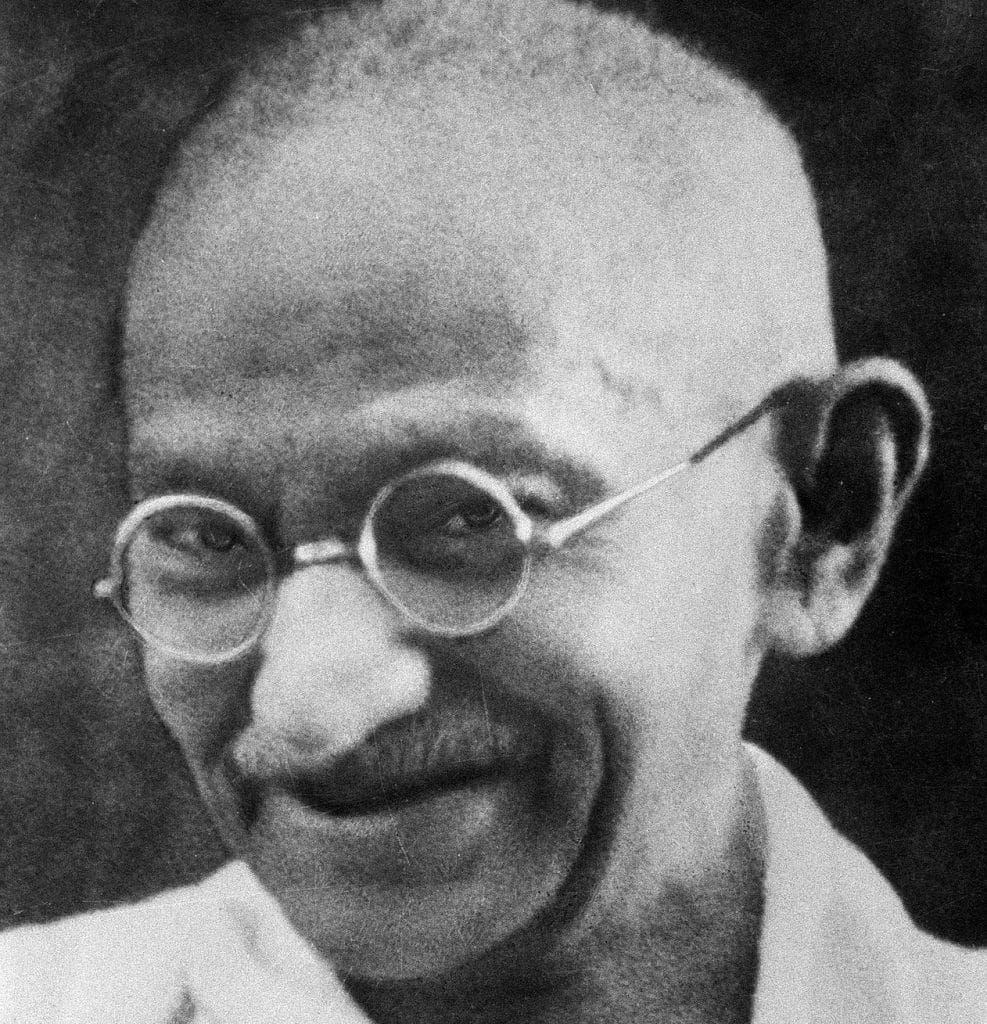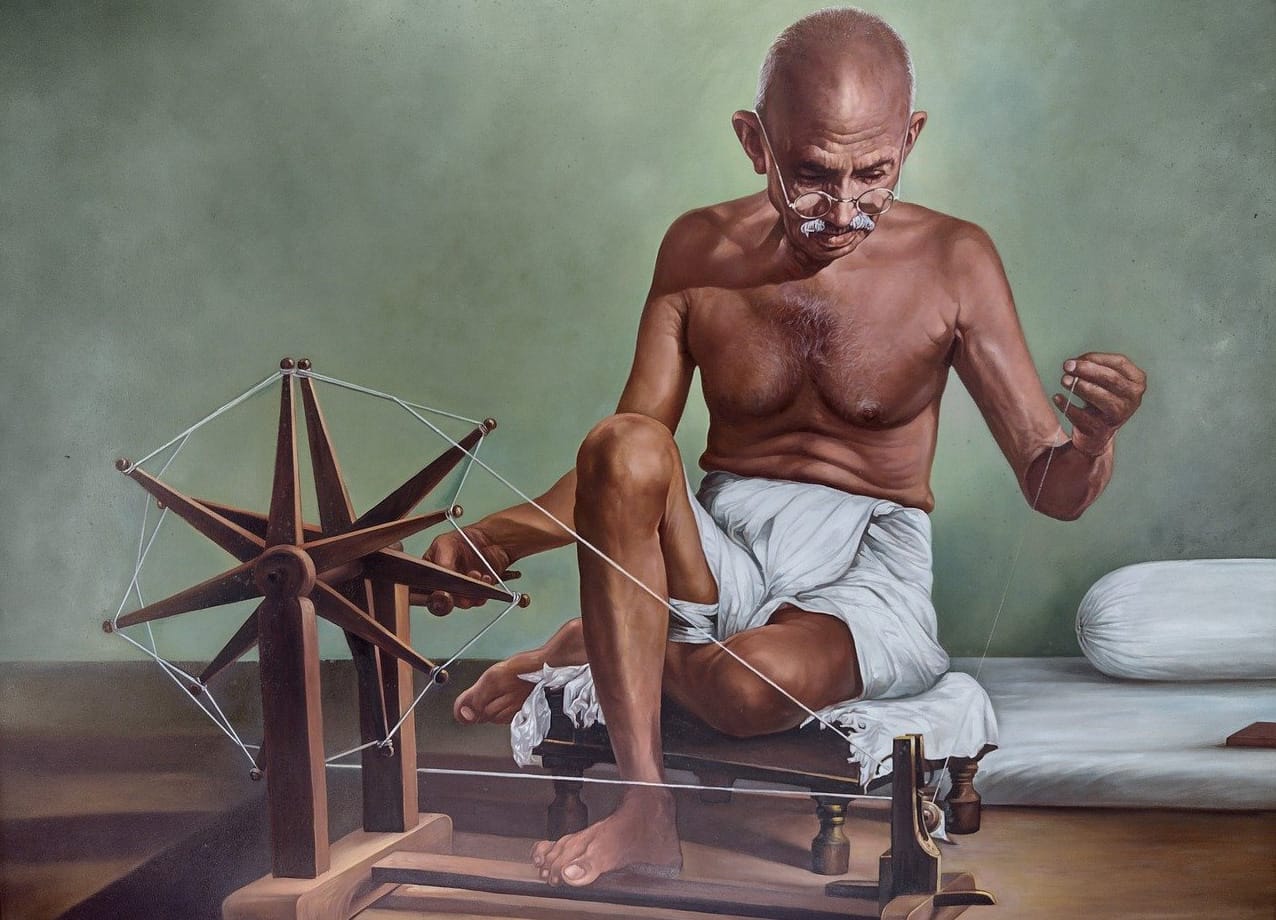It is impossible to talk about the history of India without mentioning the name of Mahatma Gandhi. His life was inspirational, his message transcended borders and his legacy lives on in every corner of the world. He was much more than a political leader: he was the soul of peaceful resistance, the architect of Indian independence and a beacon of light in the search for truth and justice.
I take you to discover Mahatma Gandhi story and his legacy in India and in the world.
Childhood and Youth: The Birth of an Idealist
Mohandas Karamchand Gandhi was born on October 2, 1869, in Bybandar,a small coastal town in the present-day state of Gujarat. Raised in a deeply religious family with strong moral values, from an early age he was influenced by the teachings of the Hinduism, Jainism and respect for all forms of life. His mother, a devout woman, instilled in him fasting as a form of purification and discipline.
At the age of 19, Gandhi traveled to London to study law. There he imbibed philosophies such as vegetarianism and the thought of authors such as Tolstoy and Thoreau, which would mark his path. But it was in South Africa, where he lived for more than two decades,where he began his active struggle against racial discrimination and injustice. It was there that his method of struggle was born: the Satyagraha (peaceful resistance).
The Struggle for Independence: Nonviolence as a Weapon of Peace
He returned to India in 1915 and soon became the voice of the oppressed. With unwavering conviction, he led peaceful protests, boycotts and historic marches. Among his most iconic movements was the Salt March 1930, where he traveled more than 300 kilometers to the coast to challenge the British salt monopoly.
Under his leadership, India achieved its independence on August 15, 1947. However, the division between India and Pakistan left a deep pain in his heart. Gandhi devoted his last months to trying to unite Hindus and Muslims in a spirit of brotherhood.
The Tragic End: The House Where He Was Murdered
With this title, you may be wondering... How did Mahatma Gandhi die, When did Mahatma Gandhi die?
January 30, 1948, Gandhi was assassinated in the Birla Bhavan house in New Delhi by Nathuram Godse, a radical opposed to his ideas of conciliation. Godse was a Hindu extremist who opposed Gandhi's stance of reconciliation between Hindus and Muslims after the partition of India and Pakistan. He considered that Gandhi had made too many concessions in favor of the Muslims and decided to end his life while Gandhi was on his way to his evening prayer in the gardens of the Birla Bhavan house.
Mahatma Gandhi death shook the world, but his message of peace and nonviolent resistance is more alive than ever.
Today, the house where he was murdered is the Gandhi Smriti, a museum is dedicated to his life, where you can see his personal belongings and the path where he walked for the last time before being shot down.
The Place of His Final Rest
Mahatma Gandhi's ashes were scattered in several sacred rivers in India, but his main memorial is located at Raj Ghatin New Delhi. This place, a simple and solemn monument in black marble with the inscription "Hey Ram!" (his last words), is a pilgrimage site for those who wish to pay homage to his legacy.
Mahatma Gandhi's Legacy: A Universal Message
Mahatma Gandhi left us with a message that continues to resonate around the world: truth, nonviolence and justice are the most powerful weapons. His inspiration has guided leaders such as Martin Luther King Jr. and Nelson Mandela. Today, his philosophy continues to be a guide for all those who seek a more just and compassionate world.
His life teaches us that the true revolution comes from the soulthat change begins within each one of us and that love will always be stronger than hate.
Final Reflection: How Do We Apply His Message Today?
Mahatma Gandhi's legacy is not only a story of the past, but an invitation to live with conscience in the present. In a world where violence and intolerance still persist, his message of ahimsa (nonviolence) remains a reminder that peace begins in our daily actions. From our personal relationships to the way we relate to the planet, compassion and truth can transform our reality.
Visiting places such as Gandhi Smriti , Raj Ghat in New Delhi is not only a journey through time, but an opportunity to connect with a philosophy that can change our lives. Because Mahatma Gandhi belongs not only to India, but to the whole world.
"Live as if you were going to die tomorrow. Learn as if you will live forever." Mahatma Gandhi
Curiosities of Gandhi

Interesting facts about Mahatma Gandhi
- He was extremely shy in his childhood and adolescence, so much so that at school he rarely spoke to his classmates.
- He fasted on several occasions as a form of protest and spiritual purification, some fasts lasted more than 20 days.
- He has been nominated for the Nobel Peace Prize five times but he never received it. In 1948, after his assassination, the committee decided not to award it to anyone because "there was no worthy living candidate".
- He led a simple and austere life. He wore a simple cotton dhoti woven by himself on his famous spinning wheel (Gandhi's spinning wheel).
- He was a strict vegetarian and promoted natural food, and even wrote a book on the vegetarian diet.
- Traveled third class on trains, although he had the opportunity to do so in the first division, as a symbol of solidarity with the poorest of the poor.
- His autobiography is entitled "Autobiography. History Of My Experiences With The Truth"in which he recounts his philosophical evolution and his path to peaceful resistance.
- Never held an official political position in the Indian government after independence.
- Believed in self-sufficiencypromoted the production of handmade fabrics as part of the independence movement.
- His last words were "Hey Ram"which means "Oh, God" in Hindi, after he was shot and killed.
Gandhian museums in India and other important sites
Gandhi Smriti - is the place where the father of the nation was shot and where he died in Delhi. There you can replicate Gandhi's last steps before he was killed.
Raj Ghat - is the resting place of Mahatma Gandhi's ashes in Delhi.
National Gandhi Museum - is located in Delhi and there you can find Gandhian artifacts, including the dhoti he was wearing on the day of his death. It is very close to the Raj Ghat so it is quite practical to make both visits if you are interested.
Mani Bhavan - The Gandhi Museum in Mumbai is located in the residence where Gandhi stayed every time he visited Bombay (over 16 years). There he prepared some of his most important campaigns in his non-violent struggle for India's Independence.
Mahatma Gandhi's Phrases
Here are some of the most famous Mahatma Gandhi's quotes (Mahatma Gandhi's motivational quotes):
"Be the change you want to see in the world."
"Live as if you were going to die tomorrow. Learn as if you will live forever."
"There is no way to peace, peace is the way."
"Nonviolence and truth are inseparable and presuppose each other."
"The best way to find yourself is to lose yourself in service to others."
"An eye for an eye and everyone will end up blind."
"Truth never harms a cause that is just."
"The greatness of a nation and its moral progress can be judged by the way its animals are treated."
"Happiness is achieved when what one thinks, what one says and what one does are in harmony."
"A coward is incapable of showing love; doing so is reserved for the brave." –
"Hatred and intolerance are enemies of right understanding."
Frequently Asked Questions
When was Mahatma Gandhi born?
Born on October 2, 1869 in Porbandar, Gujarat, India.
Where was Mahatma Gandhi born?
At Porbandar, Gujarata small coastal town in India.
How did Mahatma Gandhi die?
It was murdered January 30, 1948 in Birla Bhavan, New Delhiby Nathuram Godse, an extremist opposed to his ideals.
¿Where can I find photos of Mahatma Gandhi? original?
You can find photographs of Gandhi in museums such as Gandhi Smriti and in historical archives in India.
What did Mahatma Gandhi do for peace?
He led the struggle for India's independence through the peaceful resistance (Satyagraha)promoting non-violence and truth as fundamental principles.
When did Mahatma Gandhi die?
Mahatma Gandhi death date was on January 30, 1948 in New Delhi.
Who was Mahatma Gandhi?
He was a political and spiritual leader, the Father of the Indian Nationwho guided the independence of the country through the nonviolence and peaceful resistance.
What profession did Mahatma Gandhi have?
Era lawyeralthough he became an activist and political leader.
Short biography of Mahatma Gandhi
He was born in 1869 in Porbandar, studied law in London, fought for civil rights in South Africa and led Indian independence with his philosophy of nonviolence.
Mahatma Gandhi biography – Mahatma Gandhi's book
His most famous autobiography is "Autobiography. History Of My Experiences With The Truth"in which he recounts his path to peaceful resistance.
I hope you enjoyed this article about Mahatma Gandhi story and his legacy. And may his work continue to inspire the world 🌍 in search of peace 🕊️.


Leave a Reply